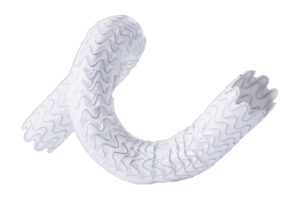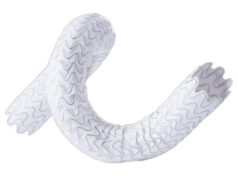 Merit Medical Systems has announced that the six-month results from the randomised arm of the Wrapsody arteriovenous access efficacy—WAVE—trial are scheduled for publication in the April issue of Kidney International, ahead of the presentation of 12-month results from the trial at the Society of Interventional Radiology’s 50th annual scientific meeting (29 March–2 April, Nashville, USA).
Merit Medical Systems has announced that the six-month results from the randomised arm of the Wrapsody arteriovenous access efficacy—WAVE—trial are scheduled for publication in the April issue of Kidney International, ahead of the presentation of 12-month results from the trial at the Society of Interventional Radiology’s 50th annual scientific meeting (29 March–2 April, Nashville, USA).
The creation of an arteriovenous fistula (AVF) to achieve long-term access to blood vessels is required for patients undergoing haemodialysis. However, narrowing of blood vessels in and around the AVF can interfere with haemodialysis delivery, resulting in potentially life-threatening consequences. The Wrapsody cell-impermeable endoprosthesis (CIE) is designed to help clinicians restore vascular access in patients on haemodialysis who experience stenosis in their venous outflow circuit.
The WAVE trial is a multicentre, international, investigational device exemption (IDE) trial designed to evaluate the Wrapsody CIE’s safety and efficacy over two years. In the randomised arm of the trial, 245 patients on haemodialysis who experienced stenosis in the venous outflow of their AVF were treated with the Wrapsody CIE (n=122) or standard percutaneous transluminal angioplasty (PTA, n=123).
Treatment efficacy was defined as the proportion of patients who did not require an intervention due to clinically driven target lesion revascularisation or target lesion thrombosis (target lesion primary patency). An additional efficacy endpoint was the proportion of patients without loss of vascular access anywhere within the circuit from the time of their initial treatment to the need for reintervention or abandonment of vascular access (access circuit primary patency).
Primary safety was defined as the proportion of patients with safety events that negatively affected the vascular access or venous outflow circuit, excluding target lesion revascularization or thrombosis, which resulted in reintervention, hospitalization, or death.
Initial results at six months demonstrated that the target lesion primary patency was significantly higher for the Wrapsody CIE vs. PTA (89.8% vs. 62.8%, p<0.0001). Similarly, the access circuit primary patency was significantly higher for the Wrapsody CIE vs. PTA (72.6% vs. 57.9%, p=0.015). No significant difference in the safety outcome was observed between treatments.
At 12 months, the Wrapsody CIE remained significantly higher than PTA for both target lesion primary patency (70.1% vs. 41.6%, p<0.0001) and access circuit primary patency (58.1% vs. 34.4%, p=0.0003).
“The Wrapsody CIE’s positive outcomes at one year address an important knowledge gap regarding the potential durability of the device,” said Dheeraj K Rajan (University of Toronto, Toronto, Canada, and WAVE trial investigator. “It is encouraging to know there is a new device available to help us prolong functional vascular access in our patients.”
“At Merit, we are pleased to continue building on the superior results of the Wrapsody CIE,” said Fred P Lampropoulos, Merit’s chairman and chief executive officer. “We are committed to improving patient care and providing clinicians with the data they need to make evidence-based decisions.”
The Wrapsody CIE received premarket approval (PMA) from the US Food and Drug Administration (FDA) in December 2024. Merit began commercialisation of the device in the USA in January 2025. The device previously received the CE mark for commercial use in the European Union (EU) and is available in Brazil.










